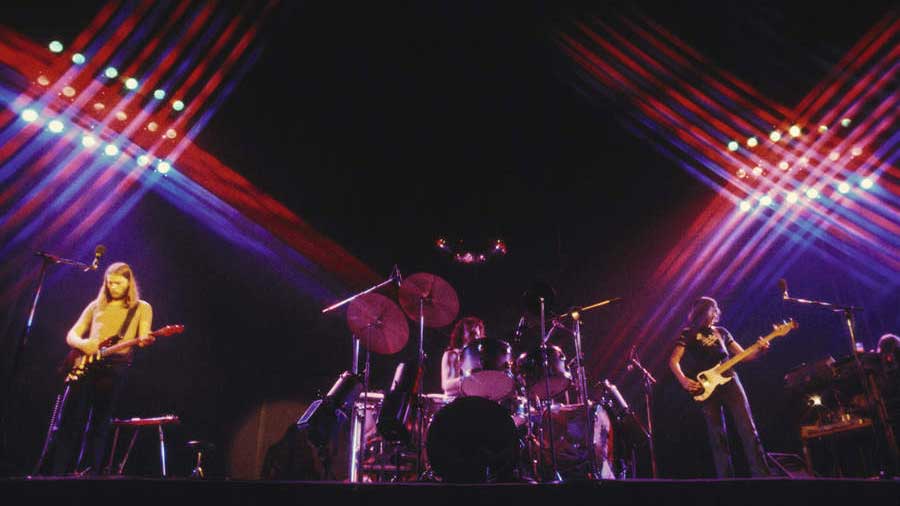One day in the summer of 2011, Pink Floyd guitarist David Gilmour was driving through London’s King Cross when he decided to look for Unit Studios. It was here, in January 1974, that he’d conjured up the four-note guitar figure that ignites Shine On You Crazy Diamond. Gilmour couldn’t remember the address, only that the tiny rehearsal room was down an alley and “an absolute shit-hole”. But it was long gone now.
From such inauspicious surroundings came a piece of music that book-ended Pink Floyd’s 1975 album Wish You Were Here and still defines them today. Although never released as a single, and running to nine parts and 26 minutes, Shine On You Crazy Diamond is Floyd’s greatest (non) hit.
In 1974 the band were reeling from the success of the previous year’s The Dark Side Of The Moon, which had jettisoned them from cult status to a US chart-topping act. But none of them knew what to do next. Instead, they toured in fits and starts, while trying to write the follow-up.
It was a daunting prospect, and there were several false starts. In December 1973 they resumed work on ‘Household Objects’, a project they’d started three years earlier. They spent eight weeks at London’s Abbey Road studios making music without using conventional instruments. Instead they created a bass line by ‘playing’ an elastic band stretched over a matchbox, a drum beat by striking a block of wood with an axe… “I think it was a delaying tactic, because we didn’t know what else to do,” drummer Nick Mason admitted.
By Christmas they had abandoned the idea. But one sound was retained: the note made by running a finger around the edge of a wine glass filled with liquid. These tuned wine-glass notes would become the first sound heard on Shine On You Crazy Diamond. In the meantime, Floyd began work at Unit Studios.
By the end of their January stint, they had work-in-progress versions of three new songs: Raving And Drooling, You Gotta Be Crazy and Shine On You Crazy Diamond. Waters’s disillusionment with the music industry had inspired the first two.
“Oh look, we’re rich,” he said. “We set out to achieve what we set out to achieve. What do we do now?”
But it was obvious whom Shine On You Crazy Diamond was about. The ‘seer of visions… you painter, you piper, you prisoner’ was Floyd’s co-founder Syd Barrett, who’d quit the group in 1968 suffering mental health issues.
“I remember feeling very sad about Syd,” said Waters. “And there was guilt there, too.”
While Floyd became rich, fêted and famous, the reclusive Barrett had abandoned his musical career and was living alone in a womb-like apartment in Chelsea, West London. Floyd went back on the road in June 1974, and premiered an early version of Shine On, dedicating it to “Sydney Barrett”. The song encapsulated a band on the cusp of stardom, but urging their old friend and former bandmate to come out of hiding and show the world what he could do. But progress was still slow when work on the new album resumed at Abbey Road in the new year.
“None of us were feeling terribly inspired,” said Mason, who recalled days spent listlessly firing an air rifle at a dartboard while waiting for inspiration to strike. Waters eventually cracked, and announced that he was ditching Raving And Drooling and You Gotta Be Crazy, and suggested turning Shine On You Crazy Diamond into the opening and closing tracks on the album. In the meantime, Waters began writing new material to plug the gap.
Slowly, a theme emerged: absence. The absence of Syd Barrett, of inspiration within the band, and – as both Waters and Mason were about to get divorced – an absence of wives and relationships.
Floyd’s tribute to Syd Barrett unfolded slowly, allowing the atmosphere to build. For such a lengthy piece of music by a band popularly regarded as progressive rock, Shine On was still rooted in the blues. Parts One to Five shifted from an eerie cinematic overture, to a hymn for Syd and then to a languid jazzy finale.
Shine On resumed on the second side of the original LP. As reflected in the writing credits, Richard Wright’s Minimoog synthesiser, Hammond organ and string synthesiser dominated much of parts Six to Nine. Wright (who died in 2008) often named Shine On You Crazy Diamond and Wish You Were Here as his favourite Floyd song and album.
On June 5, 1975, in a moment worthy of a Hollywood scriptwriter, Syd Barrett, unrecognised, shuffled into Abbey Road while Floyd were listening to a playback of the track.
“At first we thought he was someone who worked at the studio,” said Mason. “Nobody recognised him.”
The slim, elfin Syd of 1967 was long gone. Barrett had shaved his head and eyebrows bald, was heavily overweight and clutching a plastic carrier bag. Some eyewitnesses recall him asking when it was time for him to play guitar; others remember him jumping up and down while furiously brushing his teeth. Both Waters and Wright were supposedly moved to tears.
‘Sydney Barrett’ breezed out of Pink Floyd’s life as quickly as he’d arrived. None of them ever saw him again. Their tribute became the cornerstone of Wish You Were Here, an album that, despite Waters’s disgruntlement, only compounded Floyd’s position as one of the biggest bands in the world.
Shine On You Crazy Diamond remains the essence of 1970s Pink Floyd: a compelling mix of icy reserve, raw emotion and nostalgia. At 12’ 07” during the final part, the outro from Barrett’s greatest Floyd hit, See Emily Play, flits through the mix, then disappears into the ether – like Syd himself. It’s a fitting way to end the track.

